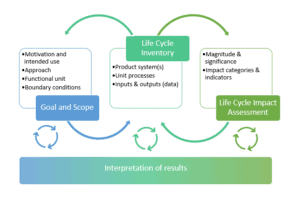How to assess the sustainability and impacts is a central question of every research project. Within the MatCHMaker project, we apply the established methodologies of Life Cycle Assessment (LCA) and Social Life Cycle Assessment (S-LCA) to evaluate the environmental and social impacts of the products and services the project is working towards.
Our partner RINA is an expert in the field of Life Cycle Sustainability. As the leading force in mapping and monitoring the industrial needs, RINA identifies the requirements and Key Performance Indicators (KPIs) of the project’s Use Cases (UCs) together with the relevant industrial partners: Heidelberg Materials for UC1 construction, Genvia for UC2 energy, and Toyota for UC3 mobility.

After a comprehensive screening and analysing process, a parametric model was then developed by RINA on the LCA study performed on the use cases, in collaboration with AIMEN for the sustainability assessment of new materials from the environmental point of view. The model will be validated on the project’s use cases, along with social impact assessment, thanks to results and evidence coming from the characterisation activities. CEA is responsible for evaluating the long-term performance and degradation of the materials, and it will also explore the social and socio-economic aspects of the project’s targeted products, on which RINA conducts the S-LCA study.
The LCA consists of four phases:
- Goal and Scope
Why do we do the assessment and how? In this phase, the reasons and intended use are described and the functional unit (i.e., the metric of the study) and modelling approaches are defined. As an example, the functional unit for the UC1 is 1 tonne of cement, hence results of the assessment are referred to that metric.
- Life Cycle Inventory
What are the data for the analysis? The inventory comprises a description of the product system(s) and unit processes, including the inputs and outputs (data) correlated to each process step. They refer back to phase 1 by linking the data to a specific functional unit.
- Life Cycle Impact Assessment
By associating the results of the life cycle inventory with impact categories and indicators, the scale and significance of impacts are evaluated based on the data compiled in phase 2.
- Interpretation
In the final phase, the findings of the previous two phases are combined with the goal and scope from phase 1 to draw conclusions and recommendations.

The main difference between LCA and S-LCA is the perspective. LCA analyses the environmental impacts, with an inventory that may include energy inputs, raw materials, products, waste, emissions and others related to environmental issues. S-LCA looks at the social and socio-economic potential impacts and the hotspots vary depending on who the identified stakeholders are (e.g. workers, local community, value-chain actors or society). The indicators for S-LCA could include human rights, work conditions, cultural heritage, health issues, poverty and political conflict, while the inventory takes cue from the LCA one with information related to economic aspects and the value-chain of inputs/outputs.
Due to the different impact categories, the phases in the methodology could also differ. The approach from the MatCHMaker project is innovative because parametric models will enable a quicker recalculation of the results from the assessment than in a traditional assessment. This is achieved with one part of the inputs remaining rigid, while another part being elastic and flexible. The model also takes the S-LCA into account, with the UNEP/SETAC Guideline (2020) serving as the reference framework of the study.
Source:
https://www.rina.org/en/life-cycle-assessment

